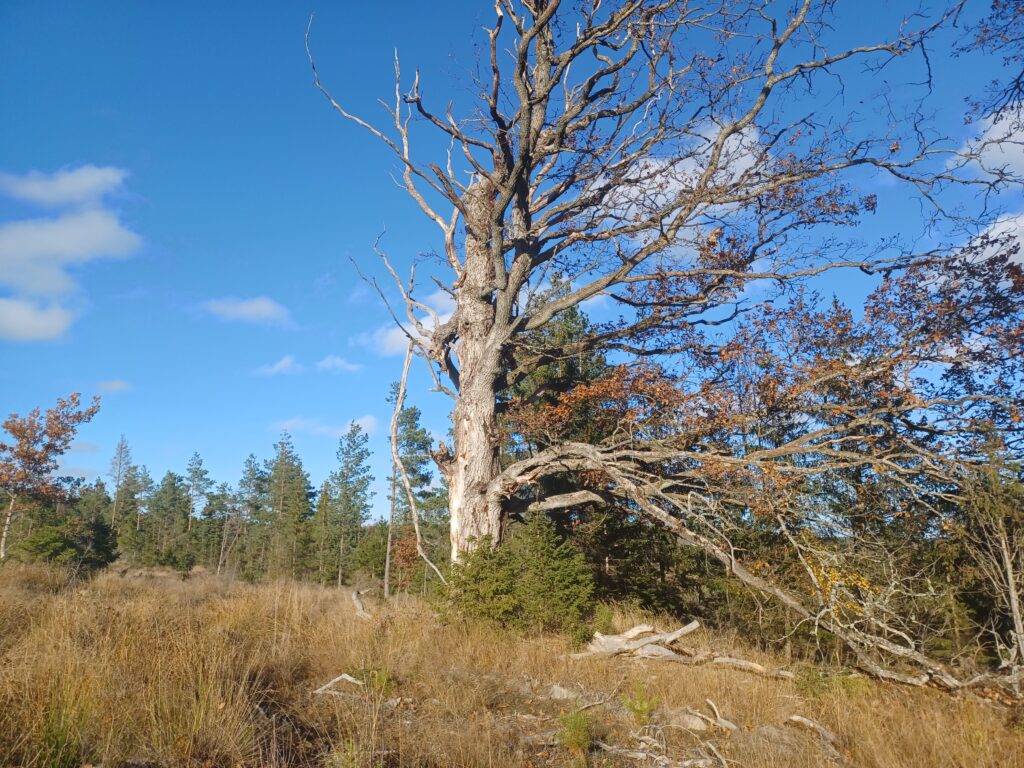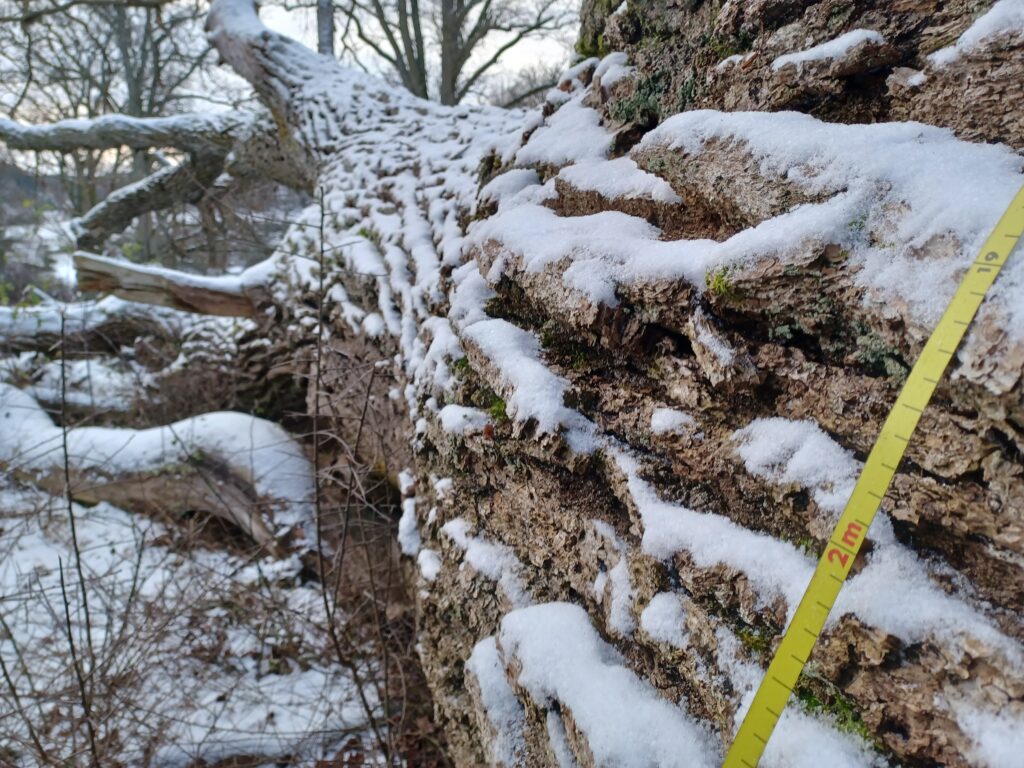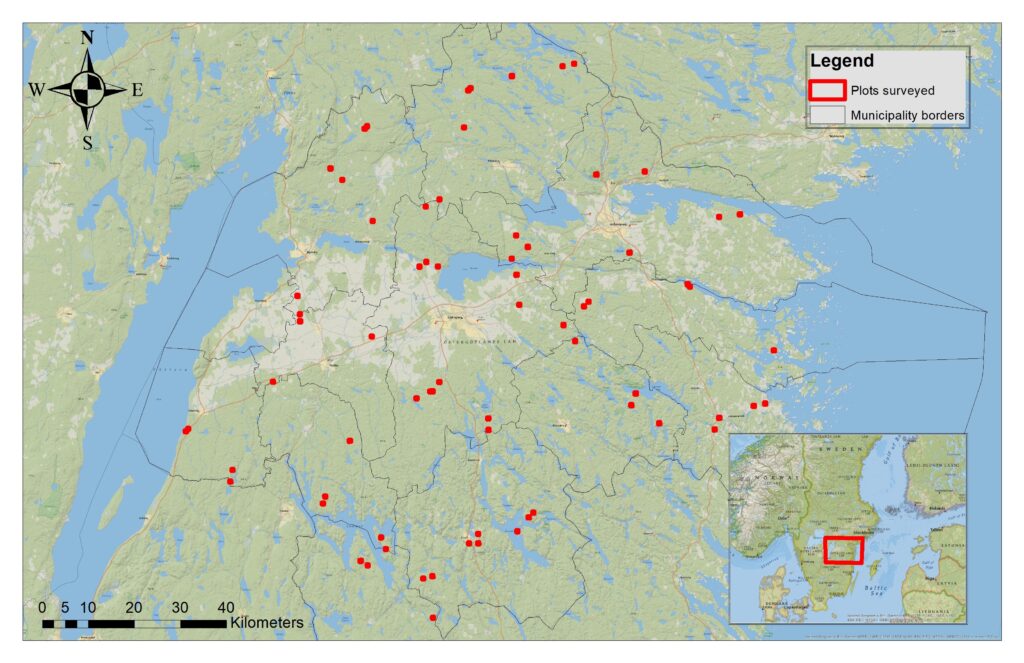Surveys
Survey of HBV trees have been performed two times. First time between 2009 and 2012. Then a second time between 2022 and 2023. In both surveys, the same areas have been visited. The surveys is based on a method called “Inventory of trees with high biodiversity value in cultural landscapes” developed on the request of the Swedish Environmental Protection Agency. In this method a set number of 500×500 m plots scattered all over Östergötland is chosen to be visited. In Östergötland 118 plots have been chosen. For this thesis, 71 of those 118 plots were randomly selected to be included.
Each plot was completely surveyed for HBV tree (Giant trees, hollow trees and old trees). Meaning that the surveyor walked the whole plot in such a way that all HBV trees should have been found. A tree in the plot was noted and examined if it meet one of the definition requirements of HBV trees. For each tree found, basic information (Species, plot, date and geographical location) was noted.



Vitality (5 stages)
For each tHBV tree found, vitality was estiamted. When estimating the vitality stage of a tree, several factors were observed on the tree such as percentage of shoot formations of the crown, bud density, loss of branches and physical damages. Evaluating these factors together gave a score on a percentual scale of 0% to 100%. The percentual score represented the trees vitality and was later divided into three stages: Healthy (>50%), Impaired (50%-20%) and Low vitality (<20%). If the tree was considered as completely dead (vitality score 0%), it was classified as either Standing dead tree or Lying dead tree.
Circumference (cm)
Circumference was aslso measured on each HBV tree. Trunk circumference was measured at the smallest place of the trunk until 1.3 m above ground.
Hollowness (5 stages)
Finally, hollowness stage was also determined on each HBV tree. Hollowness stage was be determined by the size of the largest entry hole in the wood of the tree. There are five classes that were used in determination: No entry hole (entry holes <3 cm diameter or absent), Entry hole < 10 cm diameter, Entry hole 10-19 cm diameter, Entry hole 20-29 cm diameter and Entry hole ≥ 30 cm diameter.
Vegetation surrounding oaks
Shading vegetation coverage was also estimated around and underneath living oaks trees. The type of shading estimated was that of adult trees with a stem diameter larger than 0.1 m. Specifically shading was divided into two types: adult decidious-and pine trees (DP) and Spruce trees (S). Coverage estimation of these two types of shading vegetation was further estimated in two different areas in relation to the HBV tree. First, vegetation coverage below the HBV tree´s crown projection was estimated (DPB and SB). Second, vegetation coverage 5m outside the crown projection was estimated (DPO and SO). Further, coverage was estimated as one out of 4 stages: No vegetation, vegetation coverage < 25%, vegetation coverage between 25% and 75% or vegetation coverage > 75%.
Statistical analysis
Data was transformed in the statistical software R and was afterward subjected to a Bayesian regression model to examine the effects of time on the development of vitality, circumference and hollowness of HBV trees. The Bayesian model was also used to examine the effect of circumference on vitality and hollowness. Effects were estimated separately per species/genus. The effect of DPB, DPO, SB and SO on the vitality of living oaks from 2022.2023 were also used with Bayesian regression model.
Species included in the analysis where european aspen (Populus tremula), european ash (Fraxinus exelsior), goat willow (Salix caprea), norway maple (Acer platanoides), wild cherry (Prunus avium), apple tree (Malus domestica), swedish whitebeam (Sorbus intermedia) and wych elm (Ulmus glabra). In some cases, determining species have not been possible or less reliable. Therefore, genre have been used as a taxonomical separation among oaks (Quercus), birches (Betula), alders (Alnus) and lindens (Tilia).